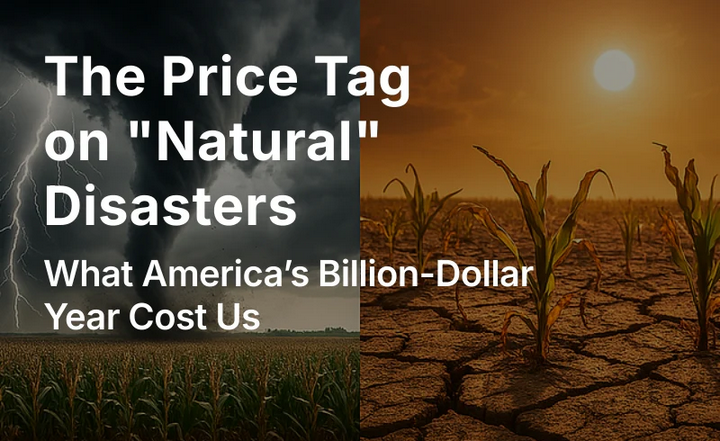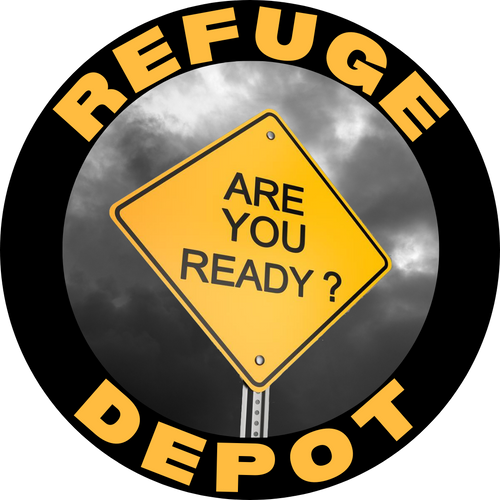
The Price Tag on "Natural" Disasters: What America’s Billion-Dollar Year Cost Us
Share
If you feel like you’ve been hearing about constant floods, fires, and storms lately, you’re not imagining it. The news cycle of disaster is relentless. But have you ever stopped to wonder what the final bill for all that destruction looks like?
I did. And the numbers I found weren’t just staggering—they paint a clear and alarming picture of a new American reality.
Let’s start with the headline figure. In 2023, the United States weathered an unprecedented 28 separate weather and climate disasters that each caused at least $1 billion in damage. The total cost? A cool $92.9 billion.
But that number, massive as it is, is just the tip of the melting iceberg. To understand the full story, we need to look at the trend.
A Record-Breaking Year… Again
That count of 28 billion-dollar events in 2023 set a new record, surpassing the previous high of 22 set in 2020. Last year’s disasters ran the gamut: a devastating drought and heatwave across the South and Midwest ($14.5 billion), Hurricane Idalia’s rampage through Florida ($3.5 billion), and a seemingly endless series of severe storms and tornado outbreaks.
Yet, in a telling sign of how complex this crisis is, 2023 wasn’t even the most expensive year on record. That honor recently belonged to 2022, which cost the nation $178.8 billion, driven largely by the catastrophic Hurricane Ian.
So, what’s going on? Are we just unlucky?
The data says no. This isn’t a blip; it’s a trajectory.
The Unmistakable (and Costly) Trend
The experts at NOAA, our nation’s official scorekeeper for climate costs, track this data back to 1980. The long-term average from 1980-2023 is about 8.5 billion-dollar disasters per year, costing around $60 billion annually (adjusted for inflation).
Now, look at the recent five-year average:
2019-2023: An average of 20.4 events per year, costing over $121 billion annually.
Let that sink in. The average year now sees more than double the number of major disasters and double the cost compared to the long-term historical average. We have entered a new era where nine-figure disaster responses are the norm.
Where is the Money Going?
Not all disasters are created equal. While we see many costly tornado outbreaks and wildfires, the real budget-busters are tropical cyclones.
The five most expensive U.S. disasters since 1980 are all hurricanes:
1. Katrina (2005) - ~$195 billion
2. Harvey (2017) - ~$156 billion
3. Ian (2022) - ~$116 billion
4. Maria (2017) - ~$101 billion
5. Ida (2021) - ~$81.6 billion
Meanwhile, the rising toll of Western wildfires and massive, continent-spanning droughts shows that the threat is truly national—and not limited to the coasts.
The Teachings of The Most Honorable Elijah Muhammad conveyed that natural disasters are manifestations of the judgments of Allah (God) upon the earth, particularly highlighting their increasing severity in America.
In "The Fall of America," he states:
- “America is surrounded with the judgments of Allah—the four great judgments of rain, hail, snow, and earthquakes…”
- “To be plagued with too much rain will destroy property and lives. It swells the rivers and creeks. Too much rain floods cities and towns.”
Excessive rain and flooding can lead to significant destruction and loss of life, which is seen as a direct consequence of divine discontent.
Furthermore, The Teachings describes snow as “one of the weapons” of destruction, highlighting how it can lead to isolation, transportation issues, and starvation as it buries infrastructure and homes.
The most profound aspect of these Teachings is the chronicling of natural disasters as a deeper spiritual phenomenon, indicating that these events are not merely random occurrences but are tied to the moral and spiritual state of the people and the consequences of their actions.
In another excerpt, it is articulated:
- “The Pacific Ocean is now angry and is raging and tossing up great waves as never before.”
This illustrates that the seas and the weather are under divine influence, further connecting the natural environment to the spiritual condition of humanity.
In the illuminating book, Torchlight for America by the Honorable Minister Louis Farrakhan stated, "
“The military budget is as great as during war time, yet senators in states with strong weapons industries fight for military budget increases so that contracts can remain in their states—in effect saying to hell with the country and its budget woes. Allah (God) has a way of showing His disapproval to those who are wise enough to read the signs. FEMA, the Federal Emergency Management Act, was enacted to finance emergencies and recoveries from national disasters. Natural disasters are God’s way of indicating His displeasure and are a sign of impending doom. FEMA doesn’t have enough money to pay for the earthquakes that hit San Francisco during the World Series a few years ago. FEMA does not have enough money to pay for Hurricane Hugo, Cyclone Omar, the hurricane in Hawaii, the tornadoes that have torn up Tampa Bay, and Hurricane Andrew.
“All of these catastrophes increase the budget deficit. And more of these catastrophes are on the way to America with ever-increasing rapidity. This is God’s way of nudging or forcing government leadership to accept real solutions to the country’s problems. Jehovah used 10 plagues against Pharaoh. Those 10 plaques, including natural calamity from snow, rain, hail and earthquakes, are seen in the world today, particular in America."
The Teachings of The Most Honorable Elijah Muhammad as taught by the Honorable Minister Louis Farrakhan view natural disasters as divine judgments, reflecting a broader spiritual landscape, where societal actions reverberate through the physical world, manifesting as natural calamities.

